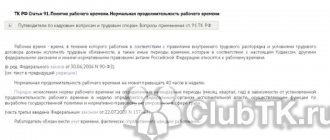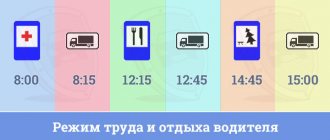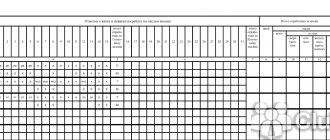Article 91 of the Labor Code of the Russian Federation with comments
Art. 91 of the Labor Code of the Russian Federation establishes that working time should be considered periods during which a specialist, by virtue of internal documents of the organization, is obliged to perform labor functions and tasks. At the same time, the Labor Code of the Russian Federation allows that other time periods can be taken into account as part of working time in accordance with the requirements of the Labor Code of the Russian Federation or some other legal acts.
Thus, working hours are not just the hours an employee actually worked. These may be other periods, which will be discussed below.
For all working specialists in Art. 91 of the Labor Code of the Russian Federation establishes a single limit for the normal duration of the work week - no more than 40 hours. At the same time, a similar limit for any calendar period (month, quarter, etc.) must be established by the federal authority whose functions include rule-making in the field of labor relations.
IMPORTANT! Companies should not forget that Art. 91 of the Labor Code of the Russian Federation prescribes keeping correct records of all hours actually worked by specialists.
What periods when a specialist did not actually work are still considered working time?
So, in addition to direct working hours, i.e. the period during which the specialist actually worked, some other time periods can be taken into account as part of the working time.
In particular, the legislator refers to such segments:
- Work breaks when a woman is feeding an infant under 1.5 years of age (Article 258 of the Labor Code of the Russian Federation). The company is obliged to provide such breaks of at least 30 minutes to the employee no less than every 3 hours during each working day by virtue of Art. 258 Labor Code of the Russian Federation. If there are two or more children under one and a half years old, then the minimum break is 1 hour.
- Periods when there was downtime in production through no fault of a specialist. The company must pay the employee for such downtime in accordance with Art. 157 of the Labor Code of the Russian Federation either in the amount of 2/3 of the average earnings (if the employer is to blame for the downtime), or in the amount of 2/3 of the salary (downtime for reasons beyond the control of the employee and the employer).
- The time when an employee has lunch or rests while performing his job functions, i.e., without interrupting work. The above is true if the enterprise, due to the nature of production, cannot provide the employee with a separate break for rest and meals, which in general should not be taken into account as part of working time (Article 108 of the Labor Code of the Russian Federation).
- Special breaks during work, during which, due to the nature of production, a break is necessary in accordance with Art. 109 of the Labor Code of the Russian Federation (letter of Rostrud dated 04/11/2012 No. PG/2181-6-1). Such breaks are established by labor regulations.
Commentary on Article 91 of the Labor Code of the Russian Federation
Working time consists of the time actually worked during the day. It may be less or more than the duration of work established for the employee. Working hours also include other periods within the normal working hours when work was not actually performed. For example, paid breaks during the working day (shift), idle time not through the fault of the employee.
The duration of working hours is usually established by fixing the weekly standard of working time.
The maximum limit on the duration of working hours is established by law, thereby limiting the duration of working hours. Article 37 of the Constitution of the Russian Federation, enshrining in paragraph 5 the right to rest, indicates that a person working under an employment contract is guaranteed the working hours established by federal law.
The Labor Code allocated working time to Section IV, consisting of two chapters (15 and 16).
Article 91 of the Labor Code of the Russian Federation defines working time.
Working time is the time during which an employee, in accordance with the internal labor regulations of the organization and the terms of the employment contract, must perform labor duties, as well as other periods of time that, in accordance with laws and other regulatory legal acts, relate to working time. Based on this, the parties to labor relations have the right to determine the boundaries of working time, establish the beginning of the working day, its end, the time for a lunch break, as well as the working time regime, through which the working hours established by current legislation are ensured.
The Code emphasizes that normal working hours cannot exceed 40 hours per week. This maximum working time applies to the vast majority of workers and is therefore legally considered a universal labor measure.
The significance of the legal limitation of working hours is that:
1) ensures the protection of the employee’s health from excessive fatigue and contributes to the longevity of his professional working capacity and life;
2) for the working hours established by law, society and production receive from each employee the necessary certain measure of labor;
3) allows the employee to study on the job, improve his qualifications, cultural and technical level (develop personality), which, in turn, contributes to the growth of the employee’s labor productivity and the reproduction of a qualified workforce.
The time during which the employee, although he does not perform his job duties, but performs other actions, includes periods of time that are recognized as working time, for example, downtime through no fault of the employee. So, for example, in accordance with Article 109 of the Labor Code of the Russian Federation, working hours include special breaks for heating and rest provided to workers working in the open air in the cold season (for example, construction workers, installers, etc.) or in closed, unheated rooms, as well as for loaders engaged in loading and unloading operations. The temperature and wind strength at which this type of break must be provided are determined by executive authorities. The specific duration of such breaks is determined by the employer in agreement with the elected trade union body.
Breaks for industrial gymnastics must be provided to those categories of workers who, due to the specific nature of their work, need active rest and a special set of gymnastic exercises. For example, drivers are entitled to such breaks 1 - 2 hours after the start of the shift (up to 20 minutes) and 2 hours after the lunch break. In relation to any other categories of employees, the issue of providing them with such breaks is resolved in the internal regulations.
According to Article 258 of the Labor Code of the Russian Federation, working hours include additional breaks for feeding the child (children), provided to working women with children under the age of one and a half years, no less than every three hours of continuous work, lasting at least 30 minutes each. Breaks for feeding children are included in working hours and are subject to payment in the amount of average earnings.
As a rule, working hours include periods for performing basic and preparatory and final activities (preparing the workplace, receiving work orders, receiving and preparing materials, tools, familiarizing with technical documentation, preparing and cleaning the workplace, handing over finished products, etc.) provided for by technology and labor organization, and does not include the time spent on the road from the checkpoint to the workplace, changing clothes and washing before and after the end of the working day, and lunch break.
In conditions of continuous production, the acceptance and transfer of shifts is the responsibility of shift personnel, provided for by the instructions, norms and rules in force in organizations. The acceptance and handover of a shift is due to the need for the employee accepting the shift to familiarize himself with the operational documentation, the condition of the equipment and the progress of the technological process, to accept oral and written information from the employee handing over the shift to continue conducting the technological process and servicing the equipment. The specific duration of shift reception and transfer time depends on the complexity of the technology and equipment.
At the same time, taking into account that Article 91 of the Labor Code of the Russian Federation gives the parties to labor relations the right to determine the principles of regulation of working time themselves, the issues of including the above time periods in working hours must be resolved by them independently. The decision made is enshrined in the internal labor regulations approved in accordance with the established procedure.
Normal working hours cannot exceed 40 hours per week in either a five or six day work week. This is the standard working time established by law (Article 91 of the Labor Code of the Russian Federation), which must be observed by the parties to the employment contract (employee and employer) throughout the Russian Federation, regardless of the organizational and legal form of the enterprise, type of work, and length of the working week. Normal working hours are a general rule and apply if the work is performed under normal working conditions and the persons performing it do not need special labor protection measures; applies to physical and mental workers. Normal working hours must be of such duration as to preserve the ability to live and work. Its duration depends on the level of development of production forces.
It should also be taken into account that the normal working hours established by Article 91 of the Labor Code of the Russian Federation apply equally to both permanent and temporary seasonal workers, and to employees hired for the duration of certain work (Articles 58, 59 Labor Code of the Russian Federation), etc.
The legislator provides for the obligation of the employer to keep records of the time actually worked by each employee. The main document confirming such accounting is a working time sheet, which reflects all work: daytime, evening, night hours of work, hours of work on weekends and holidays, overtime hours of work, hours of reduced work against the established duration of the working day in cases provided for legislation, downtime through no fault of the employee, etc.
It is necessary to distinguish between the duration of working hours during the day and the norms of working hours. The length of the working week is calculated from seven hours of the working day; the length of working time during the day may vary.
In addition to normal working hours, the Labor Code of the Russian Federation regulates issues of reduced working hours, part-time work, irregular working hours, overtime, etc.
How can a company determine the standard working hours for an employee for different periods?
As stated earlier, a single standard is established for workers - 40 hours per week.
IMPORTANT! The specified norm is common for everyone and does not depend on whether the specialist is involved in seasonal work, whether he works in the company permanently or temporarily, etc.
However, along with the standard norm, other options are also possible. They depend on the conditions under which a particular specialist was hired and what kind of specialist he is. An employee can work within the framework of a shortened work week (Article 92 of the Labor Code of the Russian Federation) or part-time work (Article 93 of the Labor Code of the Russian Federation).
For more information about part-time work, see the article “To whom and when is part-time working time established?”
First of all, the company needs to find out exactly what limit of hourly output per week should be set for a specialist (normal, shortened or part-time work week).
Next, you should determine the standard working time for the specified specialist for a longer reporting period (month, quarter, year, etc.), as well as for 1 working day. This can be done, guided by the Procedure for calculating working time standards for certain calendar periods, approved by order of the Ministry of Health and Social Development of the Russian Federation dated August 13, 2009 No. 588n.
Article 91 of the Labor Code of the Russian Federation. The concept of working time. Normal working hours
1. Part 1 of Article 91 of the Labor Code of the Russian Federation defines the concept of working time. A worker is recognized not only as the time during which the employee, in accordance with the internal labor regulations and the terms of the employment contract, must perform labor duties, but also other periods that, in accordance with the Labor Code, other federal laws and other regulatory legal acts of the Russian Federation, relate to working hours. According to the legislation, such periods are: downtime - temporary suspension of work for reasons of an economic, technological, technical or organizational nature (part 3 of article 72.2 of the Labor Code); breaks for eating at the place of work, if, according to production conditions, it is impossible to establish breaks for rest and food (Part 3 of Article 108 of the Labor Code); special breaks for heating and rest (Article 109 of the Labor Code); breaks provided to women to feed their children (Article 258 of the Labor Code), as well as to persons raising a child without a mother (Article 264 of the Labor Code), and other periods.
For example, the time of acceptance and delivery of locomotives (cars, refrigerated sections, etc.) by locomotive and train crews, crews of refrigerated sections and autonomous refrigerated cars with service compartments, as well as the time for preparing for the trip of these crews is included in working hours (see paragraph. 9 Regulations on the peculiarities of the regime of working time and rest time, working conditions of certain categories of railway transport workers directly related to the movement of trains, approved by Order of the Ministry of Railways of Russia dated March 5, 2004 No. 7 // BNA of the Russian Federation. 2004. No. 24).
For rescuers, the time it takes to perform rescue work under normal conditions, in addition to the time to conduct search and rescue work to eliminate an emergency situation, includes the time spent traveling from the gathering place to the scene of the incident, the time of conducting safety briefings, the time of preparation for work at the workplace, etc. . (clause 3 of the Regulations on recording the working time of citizens accepted into professional emergency rescue services, professional emergency rescue units for the positions of rescuers, approved by Resolution of the Ministry of Labor of Russia of June 8, 1998 N 23 // BNA RF. 1998. N 35 - 36).
2. Enshrined in Part 2 of Art. 91 of the Labor Code of the Russian Federation, the provision that the normal working time in organizations cannot exceed 40 hours per week means: the maximum working week established by law is 40 hours and is the maximum standard working time for all workers in the Russian Federation, regardless of whether , in the enterprise (organization) of what organizational and legal form they work, permanent or temporary, whether their work is seasonal, 5-day or 6-day working week. It is on the basis of this general rule that reduced working hours are established for certain categories of workers and a lower standard of working time is provided for employees of specific organizations (compared to normal) without reducing wages in accordance with general, interregional, regional, sectoral (intersectoral) agreements, and collective agreements or other local regulatory act of the organization or by agreement of the parties to the employment contract (Article 9, 45 of the Labor Code).
3. All working hours (including daytime, night hours, weekend work hours, non-working holidays, overtime work hours, hours of reduced work against the established working hours in cases provided for by law, downtime through no fault of the employee and many other information about use of working time) is taken into account in the Time Sheet and calculation of wages (Form N T-12).
Accounting for the use of working time is carried out in the Timesheet by the method of continuous registration of appearances and absences from work or by recording only deviations (absences, tardiness, etc.).
Notes in the report card about the reasons for absence from work or about part-time work, about working overtime and other deviations from normal working conditions must be made only on the basis of documents executed properly (certificate of incapacity for work, certificate of fulfillment of state duties and etc.).
Unified forms of primary accounting documentation for recording the use of working time (forms N T-12 and N T-13) were approved by Resolution of the State Statistics Committee of Russia dated January 5, 2004 N 1 (Bulletin of the Ministry of Labor of Russia. 2004. N 5).
The named unified forms of primary accounting documentation apply to organizations of all forms of ownership, except for budgetary institutions.
4. In accordance with the new part 3 of Article 91 of the Labor Code of the Russian Federation, the procedure for calculating the norm of working time for certain calendar periods (month, quarter, year) depending on the established duration of working time per week is subject to determination by the Ministry of Health and Social Development of Russia. To date, this Procedure has not been established.
How, according to the Labor Code of the Russian Federation, can an organization ensure that actual time worked is recorded?
Comply with the requirements of Art. 91 of the Labor Code of the Russian Federation, a company can apply in practice one of 3 options for recording hours worked, established by law, namely:
- Take into account the hours worked by the specialist separately for each working day.
- Keep records cumulatively for all days within 1 week, i.e. make sure that the total limit of hours worked for the week is not exceeded. However, the length of working hours on individual days may vary.
- Organize summarized accounting, in which, as in the previous case, individual days in one reporting period (for example, a month) may differ in working hours. In this case, the limit as a whole for the reporting period must be observed.
For more information about summarized accounting, see the article “Summary accounting of working time - calculation examples” .
To record each hour worked by a particular specialist, there are time sheets, the correctness of which must be monitored very carefully by the company.
Find out more about how to correctly fill out such a report card here.










